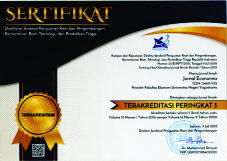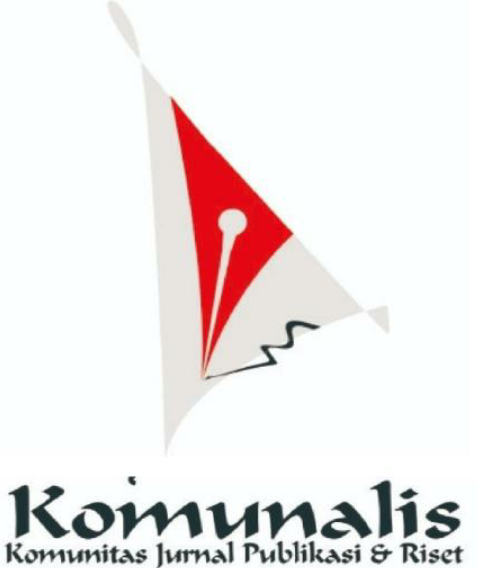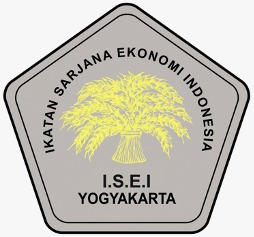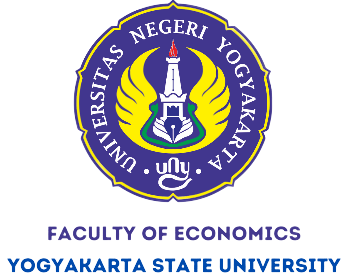Women Worker Pay Gaps: 'Sticky Floors' And 'Glass Ceilings', in Indonesia
Downloads
The study tested wage disparities across Indonesian wage distribution the peak of women's careers. Using data from the fifth wave of the Indonesian Family Life Survey (IFLS-5), the study employed logistic regression analysis. The results show that the influence of work types and health insurance on women's wage disparities has a significant and negative impact on the Glass Ceiling (GC) phenomenon, especially on private female workers, farm women workers, and unpaid female labourers. The main results of this study show that the type of work that female workers do in Indonesia is still classified the Sticky Floor (SF). The study emphasizes the need for interventions to address gender inequality in the Indonesian workforce, including gender-inclusive policies, audits, equal pay, mentorship programs, workshops, and training sessions, to create a more equitable workforce.
Downloads
Ahmed, Ather Maqsood, and Asma Hyder. 2008. “Sticky floors and occupational segregation : Evidence from Pakistan.” (Winter):837–49.
Akbar, Fakhriza. 2022. “Gender wage gap: Evidence from employment in informal sector.” The Journal of Indonesia Sustainable Development Planning 3(2):104–17.
Alabshar, Nufi, Sri Rum Giyarsih, and Agus Joko Pitoyo. 2021. “Analisis kesejahteraan migran di Indonesia.” Jurnal Litabang Sukowati 5(1):1–10.
Amaya, Elard, and Benoît Mougenot. 2019. “The gender differences in highly paid wage: A case study of Peruvian physicians.” Cadernos de Saude Publica 35(5):1–9.
Anjorin, Seun S., Mustapha S. Abba Abimbola A. Ayorinde, Daniel Mensah, Elvis A. Okolie, Olalekan A. Uthman, and Oyinlola O. Oyebode. 2019. “Equity of national publicly funded health insurance scheme under universal health coverage agenda: A systematic review of studies conducted in Africa.” Sustainability (Switzerland) 11(1):1–14.
Azmat, Ghazala, and Rosa Ferrer. 2017. “Gender gaps in performance: Evidence from young lawyers.” Journal of Political Economy 125(5):1306–55.
Bjerk, David. 2008. “Glass ceilings or sticky floors? Statistical discrimination in a dynamic model of hiring and promotion.” Economic Journal 118(530):961–82.
Bonaccolto-Töpfer, Marina, Carolina Castagnetti, and Luisa Rosti. 2023. “Changes in the gender pay gap over time: The case of West Germany.” Journal for Labour Market Research 57(1).
Brower, Ann, and Alex James. 2023. “Sticky floors, double-binds, and double whammies: Adjusting for research performance reveals universities’ gender pay gap is not disappearing.” SAGE Open 13(3):1–8.
Candolo, Cecilia. 2014. “The focused information criterion in logistic regression to predict repair of dental restorations.” Rev. Bras. Biom. 31(4):547–57.
Casini, Annalisa. 2016. “Glass ceiling and glass elevator.” The Wiley Blackwell Encyclopedia of Gender and Sexuality Studies 1–2.
Dziak, John J., Donna L. Coffman, Stephanie T. Lanza, Runze Li, and Lars S. Jermiin. 2017. “Sensitivity and specificity of information criteria.” Briefings in Bioinformatics 21(2):553–65.
Fernandez, Roberto M., and Santiago Campero. 2017. “Gender sorting and the glass ceiling in high-tech firms.” Industrial and Labor Relations Review 70(1):73–104.
Forum, World Economic. 2023. Insight Report.
Gaiaschi, Camilla. 2018. “Gender inequalities in medical careers: Evidences from five hospitals in the Lombardy region.” Italian Journal of Gender-Specific Medicine 4(2):73–78.
Ghignoni, Emanuela, and Francesco Pastore. 2023. “The gender wage gap in Egypt: Public versus private sector.” International Journal of Manpower 44(8):1511–34.
Gujarati, Damodar N. 2003. Basic Econometrics. Fourth. New York: McGraw-Hill.
Gupta, Amrita, and T. V. Sekher. 2023. “Call centers and associated health hazard for women employees: A review of health implications for women employees of transnational call centers in India.” SAGE Open 13(3):1–14.
Hou, Wangxinran, Yuyan Qin, Xingyu Wang, and Yunhan Wang. 2022. “The factors that exacerbate women’s experience of stigma in the workplace.” Pp. 191–96 in Proceedings of the 2021 International Conference on Public Art and Human Development ( ICPAHD 2021). Vol. 638.
Ismail, Rahmah, Chung Khain Wye, and Nur Sabrina Mohd Palel. 2017. “Analysis of glass ceiling and sticky floor effects for gender wage gap in Malaysian labour market.” Jurnal Ekonomi Malaysia 51(2):145–57.
Javdani, Mohsen. 2015. “Glass ceilings or glass doors? the role of firms in male-female wage disparities.” Canadian Journal of Economics 48(2):529–60.
Jaya, Risman, Ahmad Syamsu Rijal, and Irwansyah Reza Mohamad. 2020. “Karakteristik sosial ekonomi masyarakat Sub Das Alo terhadap perilaku pemanfaatan fisik lahan.” Journal of Humanity and Social Justice 2(1):53–67.
Jones, Melanie, and Ezgi Kaya. 2023. “The gender pay gap in medicine.” British Columbia Medical Journal 63(3):100–101.
Kee, Hiao Joo. 2006. “Glass ceiling or sticky floor? Exploring the Australian gender pay gap.” Economic Record 82(259):408–27.
Kleinbaum, David and Mitchel Klein. 2010. Statistics for biology and health. edited by K. K. M. Gail, J. M. Samet, A. Tsiatis, and W. Wong.
Kulik, Carol T., and Belinda Rae. 2019. “The glass ceiling in organizations.” Oxford Research Encyclopedia of Business and Management 10–11.
Linthon-Delgado, Diego, Lizethe Méndez-Heras, and Gino Cornejo-Marcos. 2022. “Sticky floor and glass ceiling in Ecuador. The evolution of the gender wage gap, 2010-2021.” CEUR Workshop Proceedings 3282:169–81.
Loganathan, Tharani, Zhie X. Chan, and Nicola S. Pocock. 2020. “Healthcare financing and social protection policies for migrant workers in Malaysia.” PLoS ONE 15(12 December):1–20.
Marge, Unt, Rokicka Magda, Täht Kadri, and Triin Roosalu. 2021. “Glass Ceiling” and ‘Sticky Floor’ in Estonian public and private sectors.” Pp. 195–209 in Gendering Post-Soviet Space: Demography, Labor Market and Values in Empirical Research.
Martinčević, Ivana, and Igor Klopotan. 2019. “Perceptions of a glass ceiling at top management positions in Croatian organizations.” Entrenova (September):392–401.
Mattisson, Kristoffer, Carita Håkansson, and Kristina Jakobsson. 2015. “Relationships between commuting and social capital among men and women in Southern.”
de Moraes Beltramini, Luisa, Vanessa Martines Cepellos, and Jussara Jéssica Pereira. 2022. “Young women, ‘Glass ceiling’, and strategies to face crystal walls.” RAE Revista de Administracao de Empresas 62(6):1–25.
Moreno-Mencía, Patricia, Ana Fernández-Sainz, and Juan M. Rodríguez-Poo. 2022. “The gender wage gap in the public and private sectors: The Spanish experience.” European Journal of Women’s Studies 29(1):72–91.
Muslim, Muhamad Ihwanul, and Mirwan Surya Perdhana. 2018. “Glass ceiling: Sebuah studi literatur.” Jurnal Bisnis Strategi 26(1):28.
Mustika, Made Dwi Setyadhi, Sutyastie Soemitro Remi, Mohamad Fahmi, and Maman Setiawan. 2022. “Analysis of educational migration decision in Indonesia.” Journal of Educational and Social Research 12(6):226–35.
Nguyen-Huu, Thanh Tam. 2023. “Wage inequality associated with job status: Evidence from Indonesia and the Philippines.” Economics Issies 28(1):57–79.
Noor, Nadia, Farida Faisal, and Mahnoor Farooq. 2023. “Horizontal hostility: A subset of glass ceiling.” Journal of Development and Social Sciences 4(III).
Nur, Muhammad Rizqi Fachrian, and Siskarossa Ika Oktora. 2020. “Analisis kurva roc pada model logit dalam pemodelan determinan lansia bekerja di Kawasan Timur Indonesia.” Indonesian Journal of Statistics and Its Applications 4(1):116–35.
Nuraeni, Yeni, and Ivan Lilin Suryono. 2021. “Analisis kesetaraan gender dalam bidang ketenagakerjaan di Indonesia.” Nakhoda: Jurnal Ilmu Pemerintahan 20(1):68–79.
Omar, Stabridis, and Salgado Cecilia. 2022. “Effects of gender and ethnicity on the wage gap among farmworkers in Northwestern Mexico.” Frontera Norte 16(1):1–23.
Passaretta, Giampiero, and Moris Triventi. 2023. “Inequality at the top. The gender earnings gap among the Italian Educational Elite.” Research in Social Stratification and Mobility 85(April 2022):100796.
Pattayat, Shiba Shankar, Jajati Keshari Parida, and Kirtti Ranjan Paltasingh. 2023. “Gender wage gap among rural non-farm sector employees in India: Evidence from nationally representative survey.” Review of Development and Change 28(1):22–44.
Purcell, David, Kelly Rhea MacArthur, and Sarah Samblanet. 2010. “Gender and the glass ceiling at work.” Sociology Compass 4(9):705–17.
Puspitasari, A., and M. Putry. 2023. “The sticky floor phenomenom a literature review.” Enrichment: Journal of Management 13(3):1813–21.
Radjab, Enny, and Andi Jam’an. 2017. Metodologi Penelitian Bisnis. Lembaga Perpustakaan dan Penerbitan Universitas Muhammadiyah Makassar.
Rincón, Guillermina Benavides, and Alejandro Díaz Domínguez. 2021. “Academic career advances and gender gap.” Political Studies Review 21(1):42–62.
Russo, Giovanni, and Wolter Hassink. 2012. “Multiple glass ceilings.” Industrial Relations 51(4):892–915.
Samodra, Yoseph Leonardo, Hui Chuan Hsu, Kun Yang Chuang, and Ying Chih Chuang. 2023. “Family economic trajectories and body mass index in Indonesia: Evidence from the Indonesian family life surveys 2 to 5.” Preventive Medicine Reports 34(February):102262.
Sari, Lola Fitria. 2020. “Religiusitas dan permintaan asuransi : Studi empiris rumah tangga di Indonesia.” Jurnal Ekonomi Keuangan Dan Perencanaan Indonesia (JEKPI) 1(1):44–53.
Segovia-Pérez, Mónica, Rosa Belén Castro Núñez, Rosa Santero Sánchez, and Pilar Laguna Sánchez. 2019. “Being a woman in an ICT job: An analysis of the gender pay gap and discrimination in Spain.” New Technology, Work and Employment 35(1):20–39.
Septiana, Ade Nuri, and Rina Herlina Haryanti. 2023. “Glass ceiling pada pekerja perempuan: Studi literatur.” Jurnal Ilmu Sosial Dan Humaniora 12(1):168–77.
Shabsough, Tina, Anıl Boz Semerci, and Azize Ergeneli. 2021. “women’s entrepreneurial intention: The role of sticky floor perception and social networking.” International Journal of Entrepreneurship and Innovation 22(1):45–55.
Shoaib, Shandana, Romy Sajjad Khan, and Sajjad Ahmad Khan. 2010. “The glass ceiling effect: A pakistani perspective.” Business Review 5(1):79–90.
Singh, Sandeep, Chetan Sharma, Purnima Bali, Shamneesh Sharma, and Mohd Asif Shah. 2023. “Making sense of glass ceiling: A bibliometric analysis of conceptual framework, intellectual structure and research publications.” Cogent Social Sciences 9(1).
Srivastava, Nidhi, and Rishikesh Nalawade. 2023. “Glass ceiling to sticky floor: Analogies of women leadership.” International Journal of Professional Business Review 8(4):1–18.
Tandrayen-Ragoobur, Verena, and Rajeev Pydayya. 2015. “Glass ceiling and sticky floors: Hurdles for mauritian working women.” Equality, Diversity and Inclusion 34(5):452–66.
Tansel, Aysit, and Elif Öznur Acar. 2017. “Labor mobility across the formal/informal divide in Turkey: Evidence from individual-level data.” Journal of Economic Studies 44(4):617–35.
Ulfa, Maria, Abd Jamal, and M. Shabri Abd. Majid. 2020. “Portrait of gender economic inequality in Indonesia.” East African Scholars Journal of Economics, Business and Management 3(1):79–85.
Vaccaro, Giannina, Maria Pia Basurto, Arlette Beltrán, and Mariano Montoya. 2022. “The gender wage gap in Peru: drivers, evolution, and heterogeneities.” Social Inclusion 10(1):19–34.
Wald, Eli. 2010. “Fordham law review the changing professional landscape of large law firms , glass ceilings and dead ends : Professional ideologies , gender stereotypes , and the future of women lawyers at large law firms the changing professional landscape of large law f.” Fordham Law Review 78(5).
Wardani, Iing Merillarosa Kharisma, Siti Nurrochmah, and Dian Mawarni. 2022. “Faktor maternal sebagai determinan stunting di Kawasan Timur Indonesia: Analisis data Indonesian family life survey 5.” Jurnal Penelitian Kesehatan Suara Forikes 13(4):229–33.
Weaver, Jessica L., Alan Smith, and Carrie A. Sims. 2021. “Is there a glass ceiling at national trauma meetings?” American Journal of Surgery 221(1):222–26.
Yasmin, Shagufta, Muhammad Jamil, and Muhammad Iqbal. 2021. “The gender wage gap in Pakistan: Extent, trends, and explanations.” Forman Journal of Economic Studies 17(02):1–30.
Copyright (c) 2025 Jurnal Economia

This work is licensed under a Creative Commons Attribution 4.0 International License.















